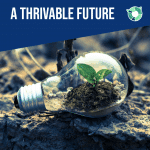If you had a chance to build a house totally on your own, without any traditional construction plan, would you do it and build a sustainable home? Fighting climate change is not easy and attempts to engineer a safe self-sufficient habitat is not new. One is reminded of the lessons from the Biosphere II endeavour. As it happens, this dream of yours can be a reality, all thanks to a renowned architect Michael Reynold, and his flagship invention, “the Earthship”, which is one of the best sustainable homes the world has seen.
An image of how an earthship looks like, an innovative sustainable home design.
Source: Earthship biotecture
His radical thinking and sustainable behaviour eventually led him to becoming resourceful, and – for example – reusing old tyres to create the “earth-rammed tyre“, the building block of his widely acclaimed architectural marvel, “the earthship“.

Image shows Michael Reynold posing with his earth rammed tyre,
the building block of an earthship. Source: Earthship history
The earthship is a sustainable home concept, and is built upon six design principles. The building block being an earth-rammed tyre. He established the Earthship Biotecture Academy in 1994, with the sole purpose to help enthusiasts build a self-sustaining house. The course is also available online for students who are not able to travel to the institute’s location in Taos, New Mexico, USA.
Michael Reynold’s design principles for earthships
Similar to the concept of a living building, every earthship is built and designed using these six elements:
1. Passive Solar Heating and Cooling
Passive heating and cooling is a concept that utilises the sun’s energy to warm the interiors of a house. One side of the structure (usually south or north, depending on the hemisphere the house is located in) is fixed with large-sized windows to allow sunrays into the house. The earthship’s walls and floors are made from earthy materials (or materials that store the sun’s heat, such as stone and mud). Such earthy materials easily absorb the sun’s heat, which is why the primary building block in these earthships consists of “rammed earth in recycled tires”.
During nights, in the absence of the sun, the stored heat within emits into the room space. This release of heat is what keeps the earthship warm and habitable even in extremely cold places. As such the design element of passive heating-cooling reduces the dependence on an external energy source, showcasing the future of climate-change resilient buildings.
Large windows feature an important element of the earthship.
Source: Earthship
2. Use of Renewable Energy
Using renewable energy sources in an earthship instead of fossil-powered electricity minimises energy use by 75%. Solar panels or wind turbine energy systems are installed to supply power. Solar represents a more cost effective solution that takes us away from the use of non-renewable fossil fuels.
3. On-site Sewage Treatment
To make the earthship totally off-grid, Reynold designed an on-site sewage treatment plant. First, he differentiated between the grey water, black water, and potable drinking water. Grey water, which typically comes from sinks, showers, and laundry, is sent to the “Grey Water Cells.” There we find specific plants at play whose roots filter the water whcih is reused to flush the toilets.
The water from the toilet is the “black water”, which flows into the septic tank system. Lined with rubber material and filled with many rubber tires designed to separate the incoming waste, specifically the liquid from the solid waste. Consequently, the liquid waste then passes into the next cell called the “botanical cell.”
Grey water treatment system in an off-grid house like earthship.
Source: Eco build Lab
4. Natural and Recycled materials
Everyone who knows the earthship knows that it is famous for its extensive use of commonly available recycled materials, especially recycled-tyre rammed with soil from the earth. This is the perfect thermal material that serves dual functions: as a good wall and a good thermal material. The use in earthships of discarded items like bottles, metal, reclaimed wood, and natural materials like mud allows for further customisatiuons. Michael strongly promotes the use of such upcycled materials to give the house a unique personality according to one’s taste.
5. Water Harvesting
In an earthship, builders incorporate a rainwater harvesting system to actively collect water in cisterns or tanks. This is then pumped through a filtration system to ensure its safety for drinking, cooking, laundry, and showering, making efficient water use a vital principle.
6. Food Production
To be completely sustainable, an earthship also grows its own food with hydroponically grown plants carefully selected and grown inside a greenhouse. These plants also play a dual role as they also help to filter the grey water.
Can Earthships be alternatives for sustainable homes?
One may definitely consider various aspects of an earthship because of its innovative and practical sustainability feature. Being less dependent on the grid for power really helps you reduce emissions and reduce those costly bills taking advantage of living off-grid. Surrounded by greenery and passive heating and cooling, this house will prove amazing in our climate change crisis years ahead. A smart and sustainable home definitely improves your health and productivity as it incorporates natural elements in its construction.
However, due to some challenges like cost of building due to expensive labour costs, earthships may not be a feasible option. But if you see the cost over a period of time, it is definitely worth the effort.
Building an earthship is a big decision. For some, the change may not be appealing and for others, it may even seem absurd. But the motto behind this blog is to stir you towards your own sustainable home. The best starting point is to include concepts from this house in your existing house.
Governments, on the other hand, can support such sustainable concepts by encouraging the development of green cities and thus more smart and sustainable homes. Such concepts will stimulates innovation and enriches communities while protecting the environment too. Offering sustainable options is a way to attract the genZ demographics, who are more invested in climate change.
Achieving the UN SDGs through Sustainable Homes
Building and living in sustainable homes like an earthship also checks the boxes of the United Nations Sustainable Development Goals. The main SDG that an earthship fulfills is SDG 11 (Sustainable Cities and Communities). The environmentally friendly concepts used in an earthship really minimises the negative carbon footprint compared to traditional housing, without neglecting the comfort of the residents.
The earthship is a role model for sustainable housing options and living practices for the future (SDG 11 goal). Earthships also contribute to SDG 13, “Climate Action”, in the following way. By reducing the need for external heating or cooling, the amount of greenhouse gas emissions is reduced, thus reducing the carbon footprint. It is simply better for the dweller and more energy efficient.
Earthships also contribute to SDG 9, “Industry, Innovation, and Infrastructure”, by showcasing innovation while building sustainable homes. Promoting the use of recycled and upcycled materials and utilising off-grid energy systems and on-site sewage systems are advancements in sustainable homes. In summary, earthships not only align with SDG 11 but also contribute to SDG 9 and SDG 13.
A Thrivable Framework for sustainable homes
Here at THRIVE, we do works relating to sustainability, and even one step ahead to thrivability. The THRIVE framework implements systems thinking and regenerative economic principles among its 12 foundational focus factors.
- Systems Thinking: An Earthship integrates energy, water, waste and food systems, truly embodying a holistic systems thinking approach towards the issues.
- Regenerative Economy: An earthship prioritizes the use of resources that promote a regenerative approach to recycling materials, composting waste and promoting self-sufficiency.
- Finite Resources: Building an earthship does not depend on finite resources but uses wastes in a smart way, making efficient use of the limited resources.
Furthermore, the THRIVE Project operates the dedicated Smart Communities outreach cluster promoting a sustainable built environment through conducting research, analysing data, and raising awareness, all geared towards driving meaningful change and achieving SDG 6, 7, 9, and 11. You may provide your support by joining the cluster by simply reaching out to us at our website and asking about sustainable homes.
How you can learn how to make a difference
You can read more about the works we do by tuning into our website, read our blogs and follow us on the links below.
- THRIVE Framework and Platform
- THRIVE Framework Playlist on YouTube
- THRIVE Framework & The Systemic Holistic Model
- THRIVE Framework Documents
- THRIVE Framework Glossary
Building a thrivable future whereby we live in harmony with nature and fair use of resources is a challenge we will need to meet head on. Procuring adequate safe shelter by way of sustainable homes for all is an important and worthwhile endeavour. With 1.6 billion living in inadequate shelter worldwide and 160 million homeless as reported by Habitat for Humanity. With a growing population, the need for access to simple, yet affordable, and efficient housing is on the rise. Perhaps Earthships will be a viable long term solution. Will you build a sustainable home?























